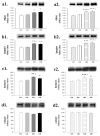Chronic administration of docosahexaenoic acid or eicosapentaenoic acid, but not arachidonic acid, alone or in combination with uridine, increases brain phosphatide and synaptic protein levels in gerbils
- PMID: 17683870
- PMCID: PMC2048660
- DOI: 10.1016/j.neuroscience.2007.06.016
Chronic administration of docosahexaenoic acid or eicosapentaenoic acid, but not arachidonic acid, alone or in combination with uridine, increases brain phosphatide and synaptic protein levels in gerbils
Abstract
Synthesis of phosphatidylcholine, the most abundant brain membrane phosphatide, requires three circulating precursors: choline; a pyrimidine (e.g. uridine); and a polyunsaturated fatty acid. Supplementing a choline-containing diet with the uridine source uridine-5'-monophosphate (UMP) or, especially, with UMP plus the omega-3 fatty acid docosahexaenoic acid (given by gavage), produces substantial increases in membrane phosphatide and synaptic protein levels within gerbil brain. We now compare the effects of various polyunsaturated fatty acids, given alone or with UMP, on these synaptic membrane constituents. Gerbils received, daily for 4 weeks, a diet containing choline chloride with or without UMP and/or, by gavage, an omega-3 (docosahexaenoic or eicosapentaenoic acid) or omega-6 (arachidonic acid) fatty acid. Both of the omega-3 fatty acids elevated major brain phosphatide levels (by 18-28%, and 21-27%) and giving UMP along with them enhanced their effects significantly. Arachidonic acid, given alone or with UMP, was without effect. After UMP plus docosahexaenoic acid treatment, total brain phospholipid levels and those of each individual phosphatide increased significantly in all brain regions examined (cortex, striatum, hippocampus, brain stem, and cerebellum). The increases in brain phosphatides in gerbils receiving an omega-3 (but not omega-6) fatty acid, with or without UMP, were accompanied by parallel elevations in levels of pre- and post-synaptic proteins (syntaxin-3, PSD-95 and synapsin-1) but not in those of a ubiquitous structural protein, beta-tubulin. Hence administering omega-3 polyunsaturated fatty acids can enhance synaptic membrane levels in gerbils, and may do so in patients with neurodegenerative diseases, especially when given with a uridine source, while the omega-6 polyunsaturated fatty acid arachidonic acid is ineffective.
Figures


References
-
- Abe K, Kogure K, Yamamoto H, Imazawa M, Miyamoto K. Mechanism of arachidonic acid liberation during ischemia in gerbil cerebral cortex. J Neurochem. 1987;48:503–509. - PubMed
-
- Abumrad NA, Park JH, Park CR. Permeation of long-chain fatty acid into adipocytes. Kinetics, specificity, and evidence for involvement of a membrane protein. J Biol Chem. 1984;259:8945–8953. - PubMed
-
- Babb SM, Ke Y, Lange N, Kaufman MJ, Renshaw PF, Cohen BM. Oral choline increases choline metabolites in human brain. Psychiatry Res. 2004;130:1–9. - PubMed
Publication types
MeSH terms
Substances
Grants and funding
LinkOut - more resources
Full Text Sources
Other Literature Sources

